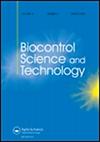用人工蛋黄培养基培养土传线虫
IF 1.2
4区 农林科学
Q4 BIOTECHNOLOGY & APPLIED MICROBIOLOGY
引用次数: 0
摘要
摘要采用皮氏培养皿,研究了斑点鱼、秀丽隐杆线虫、三角Acrobeloides bodenheimeri Acrobeloides bodenheimeri和合乳头畸形虫(Teratorhabditis synpapillata)在mcconkey、大豆酪蛋白、营养液和蛋黄培养基上体外无菌培养的适应性。除秀丽隐杆线虫能在大豆酪蛋白培养基中繁殖外,其余线虫均不能在麦康基、大豆酪蛋白培养基和营养液中生长。在25°C的蛋黄培养基中,所有线虫都成功地进行了批量培养,结果表明,接种10天后,O. tipulae (TC2和OC2)的线虫产量最高,分别达到176和150 k /平板。相比之下,叶锥虫的产量最低。采用不同的蛋黄浓度(0、5、10、20和40 g/L)对培养基进行优化,并对四种线虫进行了检测,分别为:tipulae、bodenheimeri、tricornis和synpapillata。结果表明,卵黄浓度与线虫增殖动力学呈正相关。此外,将蛋黄液培养基应用于线虫的大量培养。在含有蛋黄液培养基的培养皿中,25°C条件下,虎纹鄂头、波登海默和三角角鄂头均能繁殖。而在相同的液体培养基上则不能生长。接种后16 d,粗齿棘球绦虫和粗齿棘球绦虫的平均产量分别达到10266和4110条。接种8430只线虫后20 d,三角拟虫繁殖最多。本文章由计算机程序翻译,如有差异,请以英文原文为准。
Axenic mass culture of soil-borne nematodes using artificial egg yolk medium
ABSTRACT The amenability to axenic culture in vitro on solid medium including MacConkey, soybean casein, nutrient broth and egg yolk medium of Oscheius tipulae, Caenorhabditis elegans, Acrobeloides tricornis, Acrobeloides bodenheimeri and Teratorhabditis synpapillata were tested using Petri dishes. These nematodes were incapable of growing in MacConkey, soybean casein and nutrient broth, except for C. elegans which was able to multiply in soybean casein medium. While all nematodes used were successfully mass cultured using egg yolk medium at 25°C, results revealed that the highest yield of nematodes was observed with O. tipulae (TC2 and OC2), attaining 176 and 150 k nematodes per plate, respectively, after 10 days post-inoculation. In contrast, the lowest yield was recorded for T. synpapillata. The medium was optimised using different egg yolk concentrations (0, 5, 10, 20 and 40 g/L) and was tested for four nematode species O. tipulae, A. bodenheimeri, A. tricornis and T. synpapillata. The results showed that the egg yolk concentrations and the kinetic of nematode multiplication were positively correlated. Additionally, egg yolk liquid medium was applied to the mass culture of nematodes. Oscheius tipulae, A. bodenheimeri and A. tricornis were capable of reproduction in Petri dishes containing egg yolk liquid medium, at 25°C. Contrarily, T. synpapillata was unable to grow on the same liquid medium. The highest nematode yields of O. tipulae and A. bodenheimeri were attained 10,266 and 4110 nematodes in average, respectively, at 16 days post-inoculation. The maximum multiplication of A. tricornis was recorded at 20 days post-inoculation with 8430 nematodes.
求助全文
通过发布文献求助,成功后即可免费获取论文全文。
去求助
来源期刊
CiteScore
3.20
自引率
7.10%
发文量
64
审稿时长
4-8 weeks
期刊介绍:
Biocontrol Science and Technology presents original research and reviews in the fields of biological pest, disease and weed control. The journal covers the following areas:
Animal pest control by natural enemies
Biocontrol of plant diseases
Weed biocontrol
''Classical'' biocontrol
Augmentative releases of natural enemies
Quality control of beneficial organisms
Microbial pesticides
Properties of biocontrol agents, modes of actions and methods of application
Physiology and behaviour of biocontrol agents and their interaction with hosts
Pest and natural enemy dynamics, and simulation modelling
Genetic improvement of natural enemies including genetic manipulation
Natural enemy production, formulation, distribution and release methods
Environmental impact studies
Releases of selected and/or genetically manipulated organisms
Safety testing
The role of biocontrol methods in integrated crop protection
Conservation and enhancement of natural enemy populations
Effects of pesticides on biocontrol organisms
Biocontrol legislation and policy, registration and commercialization.

 求助内容:
求助内容: 应助结果提醒方式:
应助结果提醒方式:


